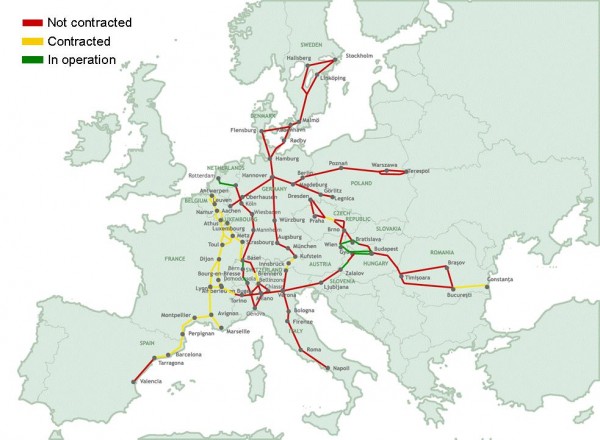The deployment of ETCS: an important test case for Europe
Posted: 31 May 2010 | | No comments yet
ERTMS, and more specifically its rail component ETCS, is arguably the technology that has caused most controversy and emotional debate amongst the railway community during the past decade. In many ways, this grand project, coordinated by the European Union, is now reaching a new and important phase in its history. The recently adopted European ERTMS deployment plan should ensure a coordinated migration to ETCS on a number of freight routes. This will open new opportunities in the long run for the railways to strongly compete with road transport.
ERTMS, and more specifically its rail component ETCS, is arguably the technology that has caused most controversy and emotional debate amongst the railway community during the past decade. In many ways, this grand project, coordinated by the European Union, is now reaching a new and important phase in its history. The recently adopted European ERTMS deployment plan should ensure a coordinated migration to ETCS on a number of freight routes. This will open new opportunities in the long run for the railways to strongly compete with road transport.
ERTMS, and more specifically its rail component ETCS, is arguably the technology that has caused most controversy and emotional debate amongst the railway community during the past decade. In many ways, this grand project, coordinated by the European Union, is now reaching a new and important phase in its history. The recently adopted European ERTMS deployment plan should ensure a coordinated migration to ETCS on a number of freight routes. This will open new opportunities in the long run for the railways to strongly compete with road transport.
So far, the deployment of ETCS has been marked by two main paradoxes. First of all, whilst originally designed to facilitate cross-border transport in Europe, ETCS has not yet gained full support from all European railways. At the same time it achieves spectacular results outside the EU. In the business world, how often is a product more successful abroad than in the area it was designed for and partially subsidised by?
And secondly, ETCS is more heavily criticised by the railways that do not invest in it rather than by those who actually do. Customers, on the contrary, seem rather satisfied by its performance. How many products in the world register a higher dissatisfaction rate amongst non-consumers than actual clients?
To any outsider, such paradoxes may seem rather obscure. The reasons behind them perhaps lie somewhere else: as such, the deployment of ETCS has become a test case, not only for interoperability in Europe, but for the European rail sector as a whole.
ETCS: a bright future ahead
Looking at the facts, there are many reasons to be optimistic about ETCS deployment.
Firstly, the common European system has now established its worldwide success. More than 33,000km of lines are either already running or are contracted to be equipped with ETCS. Nearly 50% of these are outside the European Union (EU). Countries as diverse as China, India, South Korea, Taiwan, Libya, Morocco, Saudi Arabia, Algeria, Mexico, Australia or New Zealand have opted for ERTMS. Interestingly enough, these countries choose ERTMS for different kinds of applications i.e. High-Speed lines in China; mixed traffic in the Middle East and suburban areas in Mexico. This success in non-European countries also demonstrates that the system is highly price-competitive and has a strong business case – even where interoperability is not at stake.
It is a fact that ETCS is now emerging as the global signalling standard. Tomorrow, it might well be used in other markets such as the US. In the medium run, this global domination will probably be translated into more competition, as Chinese or Japanese suppliers have been reported to work on the development of ETCS products. Interestingly, some regions such as the Middle East are even looking at ETCS as a way to ensure interoperability amongst different groups of countries – thereby opening new opportunities for the industry.
Secondly, a large number of lines have now successfully entered operation. The Spanish High-Speed network, where customers are reimbursed when delays exceed five minutes, provides a fantastic showcase for ERTMS reliability and punctuality. It has also shown how rail can actively compete and win against air traffic on common routes. In Italy, Switzerland and Belgium, ERTMS has also achieved remarkable performance levels in a multi-supplier environment. High-Speed ERTMS service also started outside Europe, for example on the 1,000km-long Wuhan – New Guangzhou line in China which was recently inaugurated. The time when ERTMS was referred to as immature or “in development” is now over: ETCS is now up and running smoothly on an ever growing network.
Thirdly, a large number of the technical open points over the past years have now been closed. A clear system of specifications management, led by the European Railways Agency, has been put in place. A stable system version (2.3.0d) was adopted in April 2008, and a clear framework has been established for the development of Baseline 3, which will become law in 2012. Considerable progress has been made with regards to supplier-to-supplier compatibilities and interoperability testing – six different suppliers are involved on the Spanish network; four on the Swiss one, etc. In many ways, the ‘teething problems’ – that were largely inherent in the development of such a grand project – now lie behind the sector. This does not mean that there are no more technical issues to be tackled, but nonetheless considerable experience has been gained by all players.
ETCS investments in Europe: a specific challenge
So why is the deployment of ETCS in Europe perhaps not as fast as one may hope? And why are European railways casting doubts on its business case?
As opposed to projects outside the EU, which are in most cases implemented in a greenfield environment, the installation of ERTMS lines in Europe requires, at least during a certain period, the double-equipment of lines and locomotives. In many cases, ETCS comes in addition to an already installed signalling system. It therefore represents an extra cost for infrastructure managers in the short term. When installed on new lines, ETCS may cause an extra cost for operators as they must install ETCS onboard if they wish to use this line – whilst at the same time keeping the existing signalling systems to run on the rest of the network/corridor.
In a country wishing to build a new network from scratch, choosing ETCS incites no debate: the standardised European system brings advantages, for example multi-supplier opportunities, increasing capacity, punctuality, reliability, granted lifetime via a global standard (legacy systems will sooner or later become obsolete!), etc. – that make it an unchallenged leader. Given that in Europe legacy systems are still in commercial and operational mode, the situation unfortunately becomes much more complex – a fact that does not contradict the business case for ETCS deployment with a view to achieving interoperability.
In the European case, ETCS can indeed only bring its full benefits if investments are adequately coordinated on a number of international lines. Otherwise, ETCS is confined to remain as yet another n+1 signalling system – i.e. an additional cost since trains will still have to be equipped with legacy systems to run on these lines.


ETCS Deployment on the six ERTMS corridors – state of play
An EU-coordinated approach: solving the prisoners’ dilemma
The main challenge with ETCS – since the very idea of having a common European signalling system emerged – is to adopt a Europe-wide coordinated approach, as this is the only way to produce a true business focus for all players – railway undertakings, infrastructure managers and suppliers alike. The current level of investments in Europe shows that the pace of implementation differs largely from one country to the other, at the expense of the EU railway community as a whole.
For an individual EU country, opting for ERTMS is in many ways similar to a prisoners’ dilemma: the first one to equip its network might be penalised as it will de facto be opened to ‘foreign’ ETCS trains without the guarantee that neighbouring countries will follow. On the contrary, a laggard may benefit from the investments made by the others. Solving this prisoners’ dilemma was one of the key rationales behind the European ERTMS deployment plan adopted in July 2009, which gradually makes ETCS investments mandatory (by EU law) along the six ERTMS corridors and a number of additional freight lines.
ETCS as a collective challenge for the European rail sector
Stalling the deployment of ERTMS has become something of a covert way to combat railway liberalisation by any other means. One cannot help wondering whether beyond the EU-led initiatives to open the European rail market, delaying ERTMS investments (and thereby preventing interoperability and easy access to all networks) is not a way for some to keep a market technically closed, thus reducing competition from foreign operators.
Today’s situation, where one country or a group of countries – for a variety of reasons – decides to prevent Europe from moving forward is totally unacceptable. Some players in Europe would be well-advised to reconsider their ETCS deployment strategy. At the end of the day, the only winners of today’s situation is road and air transport. The road benefits from a favourable competitive position whilst European railways are still squabbling and have to cope with more than 25 signalling systems!
A collective approach to ERTMS: improving the business case for European railways
Coming back to the paradoxes presented at the beginning of this article, several obvious measures may strongly improve the ETCS business case for the European railways.
Firstly, it must be stressed that in some cases, too much emphasis has been put on the actual pricing of ERTMS, rather than on its business case. Whichever way one looks at it, ETCS is not expensive per se – otherwise, it would not be purchased by railways all over the world (interestingly, despite their qualities, systems like LZB or TVM never became such worldwide successes!). Unsurprisingly, a railway operator will only purchase an ETCS onboard unit when the trackside infrastructure on which it wants to run its trains is appropriately equipped!
In other words, the main way to improve the ERTMS business case will mainly come with a coordinated deployment of ETCS. In this context, the European Commission should ensure that the ERTMS Deployment plan is effectively implemented. The shorter the migration periods, the lower the cost of double-equipment for the sector. In today’s European Single Market, such coordination would be evident to any industry sector, but it has not yet gained full consensus in the railway community!
In the same spirit, infrastructure managers could, for example, join forces and develop a clear timeline for the removal of legacy systems – which would provide clarity, planning security for railway undertakings and allow for considerable maintenance cost savings.
Secondly, having said this, another set of measures must aim at reducing the costs related to ETCS equipment, in particular to onboard units. The industry has recently launched an initiative to standardise the Train Interface Unit (TIU) – an important step towards a greater standardisation of the onboard unit. It is necessary that suppliers advance further on defining innovative solutions to lower costs and simplify the system – with the entry of ‘low-cost’ competitors on the ERTMS market this will become even more necessary.
Thirdly, some regulatory measures may also bring about significant cost improvements. Today, a major share of ERTMS onboard equipment costs relates to the approval/authorisation activities that must be performed in each country crossed by an ETCSequipped train. Granting the European Railway Agency some authorisation powers, or improving cross-acceptance, should have a significant impact on overall costs. Launching large orders of ETCS onboard units for a same series of vehicles also brings significant economies of scale – authorisation costs then become marginal.
Finally, a fourth set of measures should aim at facilitating cross-border traffic using ETCS. As long as diverging operational rules still exist, ETCS will remain a common technology without a common language. Working on a degree of harmonisation of operational rules, for example within corridor structures, would considerably facilitate putting into service of ETCS and traffic performance altogether. Innovative solutions could even be considered – e.g. is a common format for trackside tenders completely unthinkable?
Conclusions
In the end, ETCS clearly appears as a test case for Europe as a whole. It was a challenge for the suppliers, as it de facto put an end to captive markets and forced the industry to cooperate on a single standard. It is equally a challenge for the railway sector, as it forces former national monopolies to think internationally – and play the game of interoperability.
The rail sector is now faced with two choices: either to ensure the fast and coordinated deployment of ERTMS in Europe, or to face additional costs associated with a longer transition period if a minority of railways block its deployment. The considerable progress achieved in recent years calls for optimism, but the conservative attitude of some players could well result in ETCS becoming a standard faster in the rest of the world than within the EU.
There is little doubt that future generations will wonder why it took so much time for Europe to have a single signalling system. But the extent of their questioning still lies within our hands. It is high time for Europe’s rail sector to take its responsibilities seriously and meet the challenge that it faces.
About the Author
Emmanuel Brutin
Emmanuel Brutin graduated in 2004 from Lille Institute of Political Studies (a French Grande École), where he focussed on European studies and Public Relations. He subsequently completed a Masters degree in European Public Affairs before beginning his professional career in a Brussels-based Communications & Lobbying consultancy, where he was responsible for a large number of international clients in the transport sector. Emmanuel now works as a Senior Public Affairs Manager within UNIFE, where he focuses in particular on ERTMS/ETCS.
OUT NOW: The Definitive Guide to Rail’s Digital Future
The rail industry is undergoing a digital revolution, and you need to be ready. We have released our latest market report, “Track Insight: Digitalisation.”
This is not just another report; it’s your comprehensive guide to understanding and leveraging the profound technological shifts reshaping our industry. We move beyond the buzzwords to show you the tangible realities of AI, IoT, and advanced data analytics in rail.
Discover how to:
- Optimise operations and maintenance with real-time insights.
- Enhance passenger services through seamless, high-speed connectivity.
- Leverage technologies like LEO satellites to improve safety and efficiency.
Featuring expert analysis from leaders at Nomad Digital, Lucchini RS, Bentley Systems and more, this is a must-read for any rail professional.
Issue
Related topics
European Rail Traffic Management System (ERTMS), European Train Control System (ETCS), Signalling, Control & Communications







